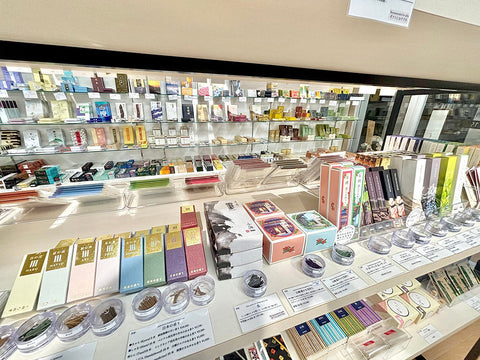Kohgen, a specialty incense shop, handles incense-related products such as incense sticks, incense burners, and fragrant woods.
At our physical stores in Tokyo and Nagoya, we often receive the question, "What is the difference between incense and aroma?"
Both incense and aroma are ways to enjoy fragrance, but are there differences in how they are enjoyed or used?
Our incense concierge will answer this question for you!
Differences between Incense and Aroma: Fragrance and Ingredients
Fragrance and Ingredients of Incense
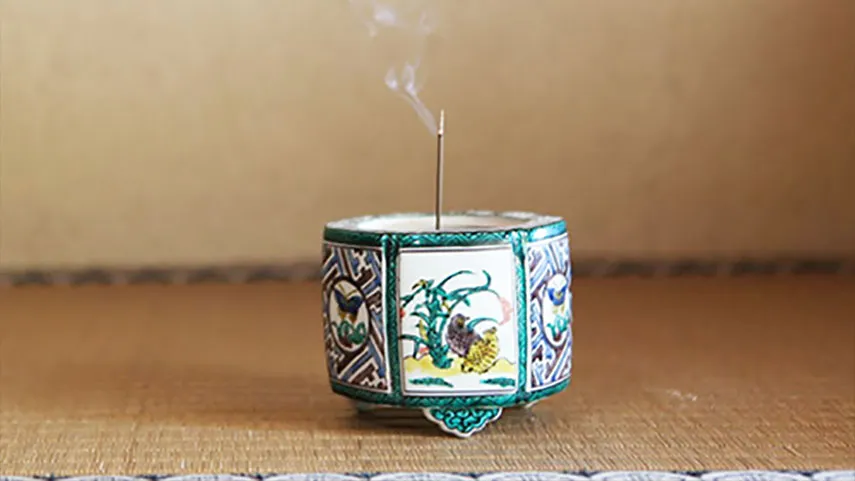
The raw materials for incense mainly consist of fragrant woods (such as Kyara, Jinko, and Sandalwood). Additionally, wood, nuts, buds, leaves, and stems used in traditional Chinese medicine are powdered and used as ingredients. Liquid fragrances, similar to those used in aroma products, are also used.
Unlike aroma, sometimes incense is made only with powdered ingredients, or by mixing powders and liquids. A major difference is that incense sticks are lit on fire. Incense produces smoke. By using smoke, the flow of air (wind) carries the fragrance further away.
※The phrase "through smoke" was also used in Europe. Perfume and fragrances are called "perfume," which originates from the Latin word per-fumum (meaning "through smoke"), and incense is considered the oldest method of scenting.
Main Ingredients of Incense

Kyara
Evergreen trees of the Aquilaria and Gyrinops genus, family Thymelaeaceae. Native to Vietnam, mainly produced in Central and Southern Vietnam.

Jinkoh (Agarwood)
Evergreen trees of the Aquilaria and Gyrinops genus, family Thymelaeaceae. English name: Agarwood. Main producing areas: Indonesia, Malaysia, Vietnam, Cambodia, Assam, Hainan Island.

Byakudan (Sandalwood)
Heartwood of semi-parasitic evergreen trees of the Santalaceae family. English name: Sandalwood. Main producing areas: Mysore in India, Indonesia, etc.

Keihi (Cinnamon Bark)
Also known as Nikkei or Nikki. Bark of trees from the genus Cinnamomum, family Lauraceae. English name: Cinnamon or Cassia. Main producing areas: Southern China, Vietnam, Sri Lanka.

Chouji (Clove)
Flower buds of the clove tree, family Myrtaceae. English name: Clove. Native to the Moluccas. Main producing areas: Indonesia, Malaysia, Africa.

Daiuikyou (Star Anise)
Fruit of Illicium verum, family Schisandraceae (Magnoliaceae). English name: Star Anise. Main producing area: Southern China.

Kansho (Spikenard)
Rhizomes of perennial herbs in the Valerianaceae family. English name: Spikenard. Main producing areas: China, India.

Mokkoh
Taproot of perennial herbs in the Asteraceae family. Native to India (Kashmir region). Main producing areas: India, Southern China.
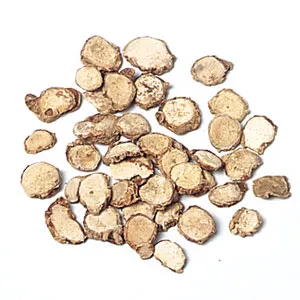
Sanna
Rhizome of Curcuma zedoaria (Zedoary), family Zingiberaceae. Also known as Kachur Sugandhi. Main producing areas: Southern China, India.

Ukon (Turmeric)
Rhizome of Curcuma longa, family Zingiberaceae. Also known as Autumn turmeric. English name: Turmeric. Main producing areas: Southern China, India, Taiwan.

Kakkoh (Patchouli)
Leaves and stems of plants in the Lamiaceae family. English name: Patchouli. Native to India. Main producing areas: Indonesia, Malaysia, Taiwan, Guangdong (China).

Haisoukou
Root of Kawamidori (same species as patchouli), family Lamiaceae. Native to India. Main producing areas: Indonesia, Malaysia, Taiwan, Guangdong (China).

Reiryoukou (Fenugreek)
Entire plant of the Primulaceae family. English name: Fenugreek. Native to Iran and India. Main producing areas: Southern China, Arabian Peninsula.

Nyuukoh (Frankincense)
Resin of evergreen trees in the Boswellia genus, family Burseraceae. English name: Frankincense. Main producing areas: Africa, Middle East.

Ryuunou (Borneol)
Crystalline granules from the tree Dryobalanops aromatica, family Dipterocarpaceae. English name: Borneol. Main producing areas: Indonesia, Malaysia.

Ansokukou (Benzoin)
Resin of evergreen trees in the Styrax genus, family Styracaceae. English name: Benzoin. Main producing areas: Indonesia, Malaysia, Middle East.

Jakou (Musk)
Secretion from the scent gland of the male musk deer. English name: Musk. Main producing areas: Tibet, Guangdong (China).

Ryuzenkou (Ambergris)
Pathological secretion (intestinal concretion) from the sperm whale. English name: Ambergris.

Kaikou (Shell Musk)
Also known as Koukoh. Operculum of large spiral shellfish such as Akashini. Main producing area: East coast of Africa.

Tabu
Bark of evergreen trees of the genus Machilus, family Lauraceae. Main producing areas: Southern Kyushu, Indonesia, China, Taiwan, Thailand, India.

Cedar Leaves
Main incense-producing regions: Nikko, Yame in Kyushu, Mikawa mountain region in Aichi.

Charcoal
Made from broadleaf trees such as sawtooth oak and evergreen oak.
Aroma Scents and Ingredients

Like incense, aroma oils also use natural fragrances. The scent components are extracted from plants such as flowers and trees, and are primarily used in liquid form as oils.
According to the standards of AEAJ (Aromatherapy Environmental Association of Japan), essential oils are defined as volatile aromatic substances highly concentrated with active ingredients derived from natural materials. What is commonly referred to as "aroma oil" may contain synthetic fragrances or be diluted with solvents like alcohol, thus including artificial components.
The materials originally used in Europe for aromatherapy were liquid fragrances, and there are three main extraction methods: 1. Cold Pressing, 2. Steam Distillation, and 3. Absolute extraction.
Before the 19th century, essential oils were mainly extracted through steam distillation and cold pressing. Steam distillation uses high-temperature steam pressure to extract the oils, while cold pressing involves mechanically pressing citrus fruit peels to squeeze out the oils.
Most essential oils, except those from citrus fruits, were extracted using steam distillation. However, this method was not suitable for delicate flowers with scents that are easily damaged by heat or water.
In the early 19th century, the discovery of benzene as a solvent led to the invention of the solvent extraction method in France in 1873. Although this method is complex and uses volatile solvents and alcohol to extract fragrance components, it preserves delicate aromatic compounds. The final product is called an "Absolute" (Abs.), meaning "pure and absolute." Absolutes, extracted using advanced techniques, are more pure and stable than essential oils, and the scent is closer to its natural state.
France, home to Grasse—a world-renowned region for natural fragrances—has long been a leader in the perfume and fragrance industry. By refining extraction technology, it aimed to maintain this status. Furthermore, the development of synthetic chemistry brought about a major transformation in the fragrance industry.
Essential Oil: 100% natural fragrance
Aroma Oil: Contains synthetic fragrance
Differences in Scent
Scents are structured in the order of lightness as follows: Top Note, Middle Note, and Base Note.
Aroma oils, being liquid, release their scents at lower temperatures compared to incense. Incense, on the other hand, contains more woody materials and requires heat to release its true aroma. It often contains a heavier component known as the "Bottom Note," which is even deeper than the Base Note. Since incense doesn't emit its scent from the Top Note alone, the fragrance can differ significantly between when you open the box and when it is actually burned.
Incense derives its fragrance from aromatic woods, while aroma oils are created by extracting scent components from plants in liquid form. As shown in the illustration, the scent first spreads as the Top Note, followed by the Middle Note as the top fades, and finally the Base Note. With incense, the heaviest Bottom Note appears at the end, lingering on porous surfaces like cloth and leaving a lasting fragrance.

- ① Top Note
- The initial impression of the scent
- ② Middle Note
- The heart of the fragrance that appears as the top note fades
- ③ Base Note
- The slowest to spread; adds depth and stability
- ④ Bottom Note
- A heavier scent than the base note; requires heat to be released
Incense Can Be Used Like Aromatherapy!
When you think of incense, you might imagine lighting it with fire, but there are also types that emit fragrance at room temperature and types that release scent when warmed without direct flame. Each has its own uses. For example...

Zukoh (Body Incense Powder)
A powdered incense applied directly to the skin—similar to perfume.

Scent Bag (Nioi-bukuro)
Fragrant materials and aromatic woods are placed in a pouch. The Japanese version of potpourri or sachets.

Fragrant Wood
Wood that emits a rich aroma when warmed. Ideal for those sensitive to smoke.
...and many more types of incense! Learn the features and uses of both incense and aroma, and enjoy fragrances even more.
Now, let's explore the different ways to use incense.
How to Use and Enjoy Incense and Aromatherapy
How to Use and Enjoy Incense
Incense can generally be divided into three types: burning type, warming type, and room-temperature type.
1. Burning Type
This is the type most people imagine when they think of incense. It offers the widest variety of scents. Easy to carry and use anywhere—at home, in the living room or entrance, or while traveling.
The main forms are stick, cone, and spiral. Each form offers different diffusion and burn times, allowing you to choose based on your purpose.

Stick Type
The most common type. Burn time varies with thickness and length. Offers the widest range of colors and scents.

Cone Type
Conical-shaped incense. The scent intensifies as it burns. Ideal for quickly filling a large space with fragrance.

Spiral Type
Spirally shaped incense. Burns for a long time, perfect for slowly enjoying scent in a large room.
2. Warming Type
Incense that emits fragrance when warmed indirectly without flame.
Recommended for those who dislike smoke or want to enjoy the pure scent of incense.
Although using a ceramic incense burner may seem intimidating, it’s surprisingly easy: fill it with ash, embed a small lit charcoal, and place the incense on top.
There are also electric incense burners that don’t require fire or ash. The fragrance spreads as the scent components are gently vaporized by the heat.

Fragrant Wood
Wood that naturally emits fragrance. Popular examples include sandalwood, aloeswood, and kyara. Also used as incense ingredients.

Nerikoh (Kneaded Incense)
Made by mixing powdered aromatic materials with honey or plum paste, then kneaded and shaped. Used moist. In the Heian era, nobles crafted it themselves.
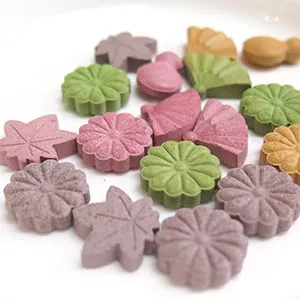
Inkoh (Pressed Incense)
Powdered incense pressed into molds. Comes in charming shapes resembling traditional sweets or wood pieces.
3. Room-Temperature Type (No Fire Required)
Incense made from chopped and blended fragrant ingredients that emit aroma at room temperature. Tucked into bags or garments for a subtle scent, or used to perfume letters or clothes.

Scent Bag
Bags filled with fragrant materials. Place in drawers, shoe boxes, or carry with you to enjoy the scent.

Zukoh
Finely powdered incense applied to the skin like perfume. Traditionally used to purify the body or ward off evil.

Fumikoh (Scented Paper)
Fragrant paper infused with scent. Slip it into letters, card cases, or wallets for a pleasant aroma.
How to Use and Enjoy Aromatherapy
Aromatherapy offers ways to enjoy scent that are different from incense.
● Aromatic Bathing
Similar to incense, but using oils from flowers, fruits, and trees to spread scent. There are many forms: aroma pots heated with candles, ultrasonic diffusers that produce mist, reed diffusers, room sprays, sachets, and more.

Aroma Pot

Aroma Diffuser
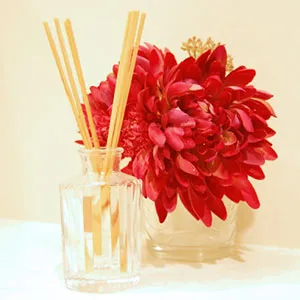
Reed Diffuser

Room Spray

Sachet
● Other Ways to Enjoy
Other uses include: adding essential oils to bathwater, inhaling them through the nose or mouth, applying oils to the body or face via compresses, facials, or massages. These offer diverse ways to enjoy scent beyond what incense can provide.



